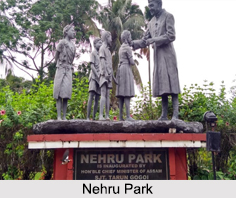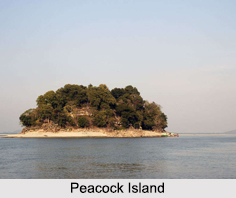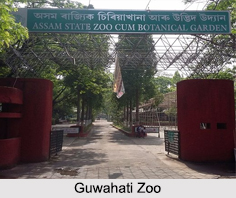 The city of Guwahati, the gateway to the north east and one of the largest cosmopolitans in the state of Assam is a true reflection of the diversity of the state and region. Commercially vibrant, the tourism in Guwahati is still flourishing with its various temples, museum and zoological garden. Discussed elaborately below are some of the famous tourist places in Guwahati.
The city of Guwahati, the gateway to the north east and one of the largest cosmopolitans in the state of Assam is a true reflection of the diversity of the state and region. Commercially vibrant, the tourism in Guwahati is still flourishing with its various temples, museum and zoological garden. Discussed elaborately below are some of the famous tourist places in Guwahati.
Digholi Phukuri: Once a naval yard used by the Ahoms in the ancient time, the Digholi Phukuri is a rectangular man made pond that was built by Bhagadatta. Currently, it is one of the most prominent tourist spots in the city, where the tourists can enjoy boat rides and other recreational activity.
 Jor Phukuri: Along the Digholi Phukuri is a pair of ponds called the Jor Phukuri, which was built by Shiva Singha to fulfil the water requirements of the Ugro Tara Temple. Historically important, the Jor Phukuri was built during the Ahom period and the main purpose for its construction was to connect the Brahmaputra River via the Naojan Channel for the naval ships and boats to operate. Presently, the twin ponds of Jor Phukuri is an excellent nesting ground for bird species like cranes, herons, egrets, etc.
Jor Phukuri: Along the Digholi Phukuri is a pair of ponds called the Jor Phukuri, which was built by Shiva Singha to fulfil the water requirements of the Ugro Tara Temple. Historically important, the Jor Phukuri was built during the Ahom period and the main purpose for its construction was to connect the Brahmaputra River via the Naojan Channel for the naval ships and boats to operate. Presently, the twin ponds of Jor Phukuri is an excellent nesting ground for bird species like cranes, herons, egrets, etc.
Nehru Park: Located in the heart of the city of Guwahati, the Nehru Park is one of the oldest parks in Assam. The park is named after the first Prime Minister of India, Jawaharlal Nehru and was initially a part of an old church that was later developed by the Assam Government. Inside the Nehru Park, there are numerous trees and 45 statues that depict the various folk dance forms of Assam. These statues portray the culture and diversity of the people of Assam. The park is one of the major tourist attractions in the city.
Peacock Island: One of the smallest river islands in the world, the Peacock Island also known as the Umananda Island is situated in the middle of the Brahmaputra River. Resembling a peacock feather, the island was thus known as the Peacock Island by the British. The island is famous for the Umananda Temple, which attracts pilgrims from all over during the time of Maha Shivaratri. Another interesting aspect of the island is the presence of the Golden Langur, which are known to be one of the most endangered species of monkey in India. These two are the prime attractions of the island that facilitates tourism.
 Guwahati Zoo: Also known as the Assam State Zoo cum Botanical Garden, the Guwahati Zoo was established in 1957 and spreads across an area of 432 acres. It is one of the largest zoological gardens in the north eastern region that preserves a unique diversity of varied flora and fauna. The zoo is home to about 895 animals, birds and reptiles representing almost 113 species of animals and birds from around the world. It is a popular tourist attraction in the city.
Guwahati Zoo: Also known as the Assam State Zoo cum Botanical Garden, the Guwahati Zoo was established in 1957 and spreads across an area of 432 acres. It is one of the largest zoological gardens in the north eastern region that preserves a unique diversity of varied flora and fauna. The zoo is home to about 895 animals, birds and reptiles representing almost 113 species of animals and birds from around the world. It is a popular tourist attraction in the city.
Kamakhya Temple: One of the oldest of the 51 Shakti Peethas, the Kamakhya Temple was built in the 10th century by the Koch king, Naranarayan. Being the centre for Tantric worship, this temple attracts thousands of tantric devotees in an annual festival known as the Ambubachi Mela. Another annual celebration is the Manasa Puja and the Durga Puja is celebrated during Navaratri in the autumn. This five day festival attracts several thousands of visitors from all over. Other than the Kamakhya Temple, there are several other Hindu temples in Guwahati that attract devotees.
The tourism in Guwahati explores the character and local flavour of the region.



















